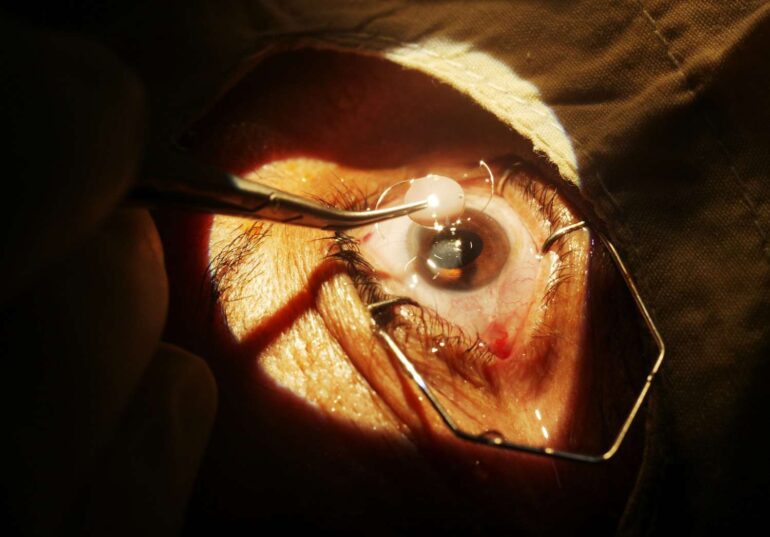TL;DR:
- Dr. Mark Packer presented on machine learning and predicting vision outcomes after cataract surgery at the 2023 ASCRS annual meeting in San Diego.
- He identified the issue of human fallibility in making subjective decisions in patient care and the selection of intraocular lenses (IOLs) for cataract surgery.
- The Oculotics program incorporates patient feedback into the decision-making process, using an algorithm to combine patient feedback and preoperative characteristics with matching interocular lens selection to patients.
- This approach can help bring objectivity and consistency to the selection of IOLs and improve patient outcomes.
- The program also improves upon traditional IOL power calculations by incorporating the real optical properties of the lens.
- Machine learning algorithms can be used to analyze large datasets of patient information to develop more accurate predictive models for visual outcomes after cataract surgery and other ophthalmic procedures.
- The use of machine learning in ophthalmology has the potential to revolutionize the field and improve patient care.
Main AI News:
Dr. Mark Packer is a well-known ophthalmologist who has identified the issue of human fallibility in making subjective decisions in patient care. He explained that doctors tend to extrapolate from their most recent experiences, which can result in inconsistent decision-making and variability in patient outcomes. This issue is particularly relevant in the selection of intraocular lenses (IOLs) for cataract surgery, where the choice of lens can have a significant impact on a patient’s visual outcome.
To address this issue, Dr. Packer introduced the Oculotics program, which aims to incorporate patient feedback into the decision-making process. This program involves giving patients an app to provide feedback on their level of satisfaction post-surgery using a 25-item questionnaire called VFQ-25. This feedback is then integrated into an algorithm along with preoperative patient characteristics such as hobbies, employment, visual demands, and anatomic factors like axial length, anterior chamber depth, and corneal curvature.
The machine learning algorithm can match interocular lens selection to patients based on a more objective and data-driven approach. This approach can help bring surgeons up to speed with premium IOLs more quickly, increase their confidence in selecting the right patients for these lenses, and ultimately lead to increased adoption of premium lenses among patients. The Oculotics program also improves upon traditional IOL power calculations by incorporating the real optical properties of the lens, such as the modulation transfer function, to help correlate lens properties with patient desires for spectacle independence.
The incorporation of machine learning and patient feedback into the decision-making process in ophthalmology has several potential benefits. By incorporating patient feedback and preoperative characteristics into the decision-making process, doctors can improve their decision-making and reduce variability in patient outcomes, ultimately leading to better patient care. This approach may also help to increase the adoption of premium lenses, which can offer several advantages, including spectacle independence and improved quality of life for patients.
The Oculotics program is a significant step in the right direction for ophthalmology, and the potential applications of machine learning in the field are vast. Machine learning algorithms can be used to analyze large datasets of patient information to identify trends and patterns that may not be visible to the human eye. This information can be used to develop more accurate predictive models for visual outcomes after cataract surgery and other ophthalmic procedures, ultimately leading to improved patient care.
In conclusion, Dr. Packer’s presentation highlights the potential benefits of incorporating machine learning and patient feedback into the decision-making process in ophthalmology. This approach can help to bring objectivity and consistency to the selection of intraocular lenses for cataract surgery and improve patient outcomes. The use of machine learning in ophthalmology has the potential to revolutionize the field and improve patient care, and the Oculotics program is a step in the right direction.
Conlcusion:
The integration of machine learning and patient feedback into the decision-making process in ophthalmology has significant implications for the market. By improving the selection of intraocular lenses and reducing variability in patient outcomes, this approach can increase patient satisfaction and potentially drive the adoption of premium lenses among patients.
Additionally, the use of machine learning in ophthalmology has the potential to revolutionize the field and improve patient care, which could lead to increased demand for ophthalmic services and products. As such, companies operating in this market may benefit from investing in machine learning technologies and incorporating patient feedback into their decision-making processes to improve patient outcomes and gain a competitive edge.

